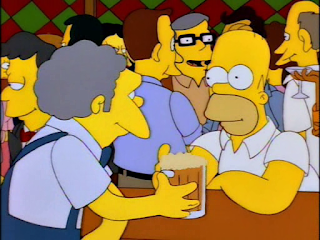It's commonly assumed that a general feeling of alcohol being the root of many societal ills was the driving force behind the 18th Amendment, known better as Prohibition. The rest of the story is much more interesting and intricate.
But first, the text:
1. After one year from the ratification of this article the manufacture, sale, or
transportation of intoxicating liquors within, the importation thereof into, or the
exportation thereof from the United States and all territory subject to the jurisdiction
thereof for beverage purposes is hereby prohibited.
2. The Congress and the several States shall have concurrent power to enforce this article
by appropriate legislation.
3. This article shall be inoperative unless it shall have been ratified as an amendment to
the Constitution by the legislatures of the several States, as provided in the Constitution,
within seven years from the date of the submission hereof to the States by the Congress.
That's is - no more Happy Hour, no more champagne toasts at weddings, no more cold beer after mowing the lawn. What a nightmare! But how did it happen?
Rather than trying to summarize, let me offer a link to an absolutely fascinating article about the genesis of Prohibition and the man who was the main motivator for it - a man you almost certainly never heard of - Wayne Wheeler.
http://www.smithsonianmag.com/history/wayne-b-wheeler-the-man-who-turned-off-the-taps-14783512/
Naturally, there was widespread controversy, widespread protest and let's face it, widespread ignoring of the law. But from January 16, 1919 until December 5, 1933, it was the law of the land, which left us with a legacy of lawbreakers like the bootleggers and crime bosses like Al Capone. The law was a failure, so it was finally repealed by...
Amendment 21
Section 1. The eighteenth article of amendment to the Constitution of the United States is hereby repealed.
Section 2. The transportation or importation into any State, Territory, or possession of the United States for delivery or use therein of intoxicating liquors, in violation of the laws thereof, is hereby prohibited.
Section 3. This article shall be inoperative unless it shall have been ratified as an amendment to the Constitution by conventions in the several States, as provided in the Constitution, within seven years from the date of the submission hereof to the States by the Congress.
Section 1 of the amendment repealed the 18th, getting rid of the federal ban on alcoholic beverages. Pretty simple. But...
Section 2 essential made liquor laws state issues. States were free to allow or disallow alcohol according to its own laws, and several states indeed remained "dry", the last one to re-allow alcohol was Mississippi, in 1966. Other laws stayed on the books longer, for example, Kansas prohibited public bars until 1987.
However, federal influence over alcohol sales did not end entirely. As recently as 1987, the State of South Dakota sued the federal government (and lost) over the loss of federal highway funds due to the state's allowing of the sale of certain low-alcohol-content drinks ("near beer") to people under 21.
And now, the final entry in our exploration of the Amendments to the Constitution:
Amendment 27
This is one of the shortest amendments, word count-wise, but has the distinction of taking the longest of all the amendments to finally be ratified.
No law, varying the compensation for the services of the Senators and Representatives, shall take effect, until an election of Representatives shall have intervened.
In effect, it means that Congress cannot just vote itself a raise just any old time it wants to. If a raise is approved by Congress, the increase does not take effect until after the next election, ensuring that the voters have a chance to vote out anyone they feel was a little too greedy in their increase. This has the effect of tempering the amount of a raise Congress is willing to give itself. Too big a raise, and they risk being voted out of office.
But the really interesting part of this amendment is that it took a mere 202 years to be ratified. You read that right: over two centuries passed from the time it was brought before Congress until the last requisite state ratified it. The amendment was actually number two in an original twelve proposed by the first Congress. The first on that list, dealing with numbers of representatives, was never ratified, and original amendments 3-12 became what we know as The Bill of Rights (so the amendment we know as the First Amendment started out as the third, and so on).
The first state to ratify the eventual 27th Amendment (and remember, it was the original second amendment!) was Maryland in 1789. Six more states added their approval by 1792, but after that, no other state voted to ratify for another 80 years, when Ohio voted in favor in 1873. And then, it was another century before Wyoming approved in 1978. Twenty-two more states ratified in the 1980s and finally, in 1992, Michigan put it over the top. And to think, all that time, COngress could just raise its salary whenever it wanted.... Good work if you can get it, right?
Well, that's it for the amendments. What shall we talk about next?

